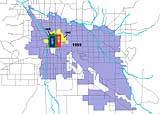
| ch. 2, pp. 7 - 8 |
Obtaining a reliable supply of potable water was a problem even in the early days. In 1870, John Bourke complained of the many holes in the town which he said were abandoned wells. “... wells, which were good and sweet in the first months of their career, but generally became so impregnated with ‘alkali’ that they had to be abandoned; and as lumber was worth twenty five cents a foot, and therefore too costly to be used in covering them, they were left to dry up of their own accord, and remain a menace to the lives and limbs of belated pedestrians.” He describes an incident in which an inebriated citizen fell down an empty 25-foot well. The area near Sentinel Peak was dominated by farms with a network of irrigation ditches that directed water from rivers and springs. These uses left little water in the river north of the Congress Street Bridge. During the 1870s, the city made three attempts to increase the water supply. The city contracted to have artesian wells drilled, but that effort failed. The city awarded another contract to a well driller who was to receive one block of city land for every successful well drilled, but that effort also came to naught. Some entrepreneurs south of town started building a canal to bring water to Tucson from Canoa (near present-day Green Valley), but that, too, proved unsuccessful. By the 1880s, many people had their own windmills, but the windmills often were still during the dry months when little wind was blowing. The demand for water had become so great that springs were no longer dependable. The then-recently formed Tucson Water Company gets credit for first successfully tapping a new water source. With a franchise from the city, the company built a distribution system to bring water from Valencia Road to downtown Tucson via a redwood flume laid in the river and a 4.5-mile-long water pipe made of sheet metal coated with tar. Following this success, the Tucson Water Company in 1889 installed its first steam-driven pumping plant and dug a 40-foot deep well, capable of pumping 1,250 gallons per minute. Water came to town along the alignment of what is now Osborne Street, which is why a diagonal street is there today instead of the north-south, east-west grid common in other older sections of town. This new water source would have solved the supply problem if Tucson’s population had not continued to grow and if droughts did not periodically occur. In 1892, the City Council debated limiting irrigation to nighttime hours because of water shortages, but did not pass the ordinance. The mayor, however, ordered the water supply to city parks be cut off. It was not until 1903 that the City Council (which now owned the water company) passed an ordinance limiting irrigation to between 5 a.m. and 8 a.m. and between 5 p.m. and 8 p.m., with a maximum fine of $50 for violations. In 1900, the City of Tucson bought the Tucson Water Company and its southside wells for $110,000 and formed the Water and Sewerage Department. Hetty Green, a wealthy New York financier, bought the bonds to finance the purchase. Things did not go smoothly at first. In 1908, Mayor Heeney decided to remove the water superintendent without consulting the City Council. As Councilman Moses Drachman explained, “The row which this precipitated lasted to December of that year and finally resulted in the council removing Mayor Heeney from office for misconduct.” (Many other differences of opinion and accusations of scandal also contributed to the mayor’s dismissal.) Also in 1908, the city faced its first water crisis when a new residential district was established, way out in the country between the University of Arizona and the railroad tracks. The windmills installed on home sites couldn’t produce enough water so residents demanded that the city extend the water system to service the district. The city authorized the water superintendent to spend $260,000 to expand the system northward. In 1911, when citizens started complaining of their water bills, which were based on a flat rate per month, the city installed meters, at first only for the complainers and later for everyone. From then on people paid according to use.
In 1914, another bond issue financed six new wells and a reservoir, at the far east side of town at Second and Campbell. A new pumping technology was installed that could produce one millions gallons of water per day from one well. Windmills could extract water from shallow wells, but the new gas or electric pumps were much more efficient and could lift water from greater depths. By 1920, water shortages again were a problem, and the City Council again banned watering except between 5 a.m. and 8 a.m. and 5 p.m. and 8 p.m. with a maximum fine of $50 for violations. The City Council also hired a staff person to provide water conservation information to the public. Meanwhile more wells were dug north of town to improve the water supply and increase water pressure for fighting fires. Over the years, more wells were added either by buying private water companies or by digging wells, until a peak of 61 wells was reached on the north side, eight of which are still active today. By that time the system had expanded and parts of the city were as much as 80 feet higher than downtown. To accommodate the situation, the city was divided into two separate pressure zones. Water circulated separately in each zone, because it could not easily be lifted to the higher areas. In later years, the zones were connected with booster stations.
Wells were generally around 50 feet deep at this time, but water levels were dropping, and people with shallower wells had problems. Groundwater pumping near the Santa Cruz River began to affect river flow, but not until the 1940s did this pumping finally caused the water table in the area to drop so low that the river flowed only during floods. During the 1930s and 1940s, population growth slowed. In response, the water system expanded less rapidly, although the city drilled ten new wells and purchased several water companies during this period.
|


